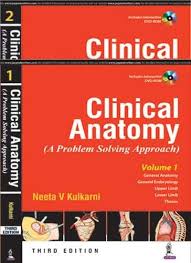Clinical Anatomy: A Problem Solving Approach (2 Volumes) with DVD-ROM
no information available
1. Integration of anatomy and its clinical relevance in all branches of Anatomy like gross anatomy, microanatomy, osteology, embryology, radiology, etc. 2. Developing student awareness that gross anatomy can be learnt from plain radiographs, CT and MRI scans and from intraoperative photographs taken during the operation on the patient. 3. Training of students in solving clinical problems by anatomical knowledge is undertaken by exposing the students to clinicoanatomical problems (case-based problems). In this way, the students become aware about the essentiality of anatomical knowledge during clinical training. 4. Thorough revision of all the chapters (especially, general embryology, general anatomy and osteology) and addition of new educative diagrams is undertaken, keeping in mind the difficulties of students in learning anatomical facts. 5. Introduction of the so-called dialogue boxes (Student Interest) throughout the text is a novel idea for giving practical hints on how to learn a topic. The important points are re-emphasized so that the students’ interest in the topic is enhanced. The dialogue boxes also highlight Must know topics in Anatomy and are useful before the commencement of theory and practical examinations. 6. Embryologic Insight boxes highlight the precise developmental sources of the structure or organ and Clinical Correlation boxes highlight the clinical importance of the structure or structures. 7. Added Infromation boxes are for the postgraduates and the teachers. In this way, an undergraduate student is kept out of the extra burden. The third edition of Clinical Anatomy (A Problem Solving Approach) (Volumes 1 and 2) caters to the present-day needs of the undergraduate students. ... Read more Read less











